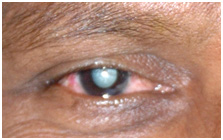
Normally, the lens in the eye is clear, allowing light rays to pass through easily and focus on the retina to get clear vision. As cataract develops, the lens becomes cloudy as in the picture above and interferes with the transmission of light. The resulting image on the retina is thus blurred.
Causes
It usually occurs in patients above the age of 40. In some cases, it occurs in children too- Eye diseases such as glaucoma, iritis, eye tumors and diabetes may lead to cataract- Prolonged use of steroid drugs and eye injuries
Symptoms
- Blurring or dimness of vision
- Feeling of a film over the eyes
- Sensitivity to light and glare-
- Change in colour of pupil


Treatment
Removal of the clouded lens by surgery and implantation of an intraocular lens.- Glasses can be used in the earlier stages to get clear vision.- Medicines or glasses will not cure cataract.
Kindly note:
Cataract is not contagious
Removal of the clouded lens by surgery and
implanting an artificial lens is the treatment.
Cataract surgery
Cataract surgery is done under local anaesthesia for adults and general anaesthesia for children. The ophthalmologist removes cataractous lens either manually or with the help of a PHACO machine. An artificial intraocular lens is then placed so as to regain clear vision. It is the ophthalmologist who decides whether the patient can undergo surgery by PHACO method or manually.
Intraocular lens (IOL) implantation
IOL is a tiny transparent convex lens, made of a harmless plastic substance (polymethylmethacrylate / acrylic) inserted in the eye during surgery. Unlike contact lenses, an intraocular lens stays permanently in the eye and does not move with change in the posture. It does not cause any irritation and provides clear vision. There are different types of IOLs. The doctor / counsellor will help you choose the best suitable IOL.

Phacoemulsification Surgery
The latest technique in cataract surgery is phacoemulsification. In this, the surgeon makes a very small incision (about 3mm). Cataract lens is broken by a small ultrasonic probe inserted through this opening and is simultaneously suctioned from the eye. It is then replaced by intraocular lens. In most instances, good vision returns early in the post-operative period.

